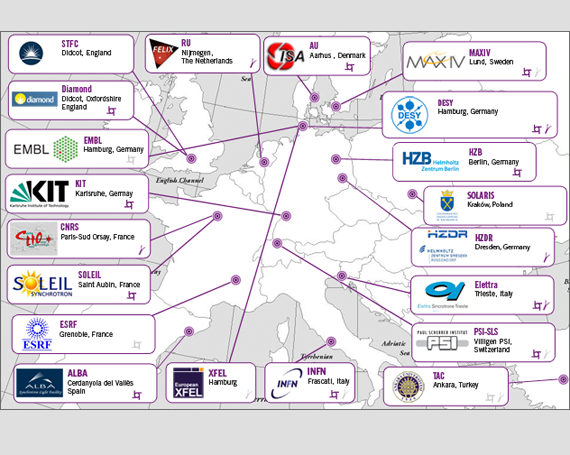Facilities Overview
Synchrotron Radiation (SR), Free Electron Laser (FEL), Neutron Beam (NB) and Muon Beam (MB) facilities represent very large capital investments by their respective countries, national research foundations, institutes or laboratories. In total there are about 45 SR facilities world wide, about 13 FELS worldwide, a good deal more NB facilities and a few MB facilities. See lightsources.org and neutronsources.org for more details on all these facilities worldwide.

A brief guide to the EU based SR and FEL facilities are shown to the right. A much more comprehsive guide to all the EU based SR and FEL sources and all of their respective experimental beamlines is available from the wayforlight website. This lists the 308 separate beamlines available across the 13 EU SR sources and the 8 EU FEL facilities. Of these only the European Synchrotron Radiation Facility (ESRF), with 54 of these beamlines, is unavailable to Irish researchers as Ireland is not a member of the ESRF international treaty organisation. All other beamlines and facilities are open to scientific proposals from Irish researchers and have been supported by EU Trans National Access (TNA) programmes.
Similarly, there are numerous NB and MB sources across the EU, of which 10 NB and 2 MB facilities are open to proposals from Irish researchers and which are supported by Eu funded TNA programmes. This does not include the Institut Laue Langevin (ILL), as Ireland is not a member of the ILL international treaty organisation.
Trans National Access to facilities
Trans National Access or TNA to select SR, FEL, NB and MB facilities has been funded in the past through the EU Research Framework Programmes Integrating Activities components. More details of these specific activities are on a separate webpage on EU Research Infrastructures support. However, it should be noted that continued TNA access is in danger and the ability of Irish researchers to continue to access these facilities is severely threatened.
Which large scale facilities do Irish researchers use?
Please see the section on Irish Research Activity, the map of Irish usage of these research facilities, and the listing of Irish research groups who use these facilities.
How do Irish researchers access these facilities?
Please see the detailed discussion on Accessing Facilities, but it should be noted that no Irish group has guaranteed access to any of these facilities or their equipment. All Irish researchers compete internationally against scientists from across Europe and across the rest of the world for time at these facilities and their separate specialised experimental equipment. This competition for time is via an objective and competitive peer-reviewed scientific proposal process. Irish researchers have a good success rate in writing excellent scientific proposals which are then awarded time at these facilities, with an effective investment of time and resources by the facility in the science proposed by the Irish researcher.
